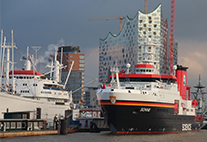Research Vessel SONNE Draws 6,000 Visitors
26 November 2014

Photo: UHH/CEN/T. Wasilewski
More than 6,000 visitors toured the brand-new deep-sea research ship SONNE in Hamburg. The SONNE had already entered port ...
More than 6,000 visitors toured the brand-new deep-sea research ship SONNE in Hamburg. The SONNE had already entered port on Thursday, accompanied by a small parade, and docked at the Überseebrücke. On Friday alone, ca. 2,100 ship enthusiasts flocked to the Open Ship; on Saturday (and despite the poor weather) the number of visitors was an impressive 4,200. The SONNE’s visit to Hamburg is part of a two-week introductory circuit with stops in Wilhelmshaven, Bremen, Hamburg, Warnemünde and Kiel.
Highlight: the ship’s bridge
For those touring the dazzling red, white and black ship, the highlight was the bridge, where Captain Oliver Meyer was happy to answer their questions. The tour also included glimpses into a scientists’ cabin and was rounded out by an exhibit on oceanographic research, in the ship’s hangar and the adjacent labs.
Ocean and climate
In the exhibit room dedicated to “climate,” the interactive monitor provided by Universität Hamburg’s Center for Earth System Research and Sustainability (CEN) was a real eye-catcher: a combination of videos, graphics and images gave visitors light-hearted impressions of the latest research on ocean currents, showing them e.g. how the Gulf Stream affects the climate in Europe. Other sights included a model of a cutting-edge ocean-floor drilling device and an autonomous ocean glider designed for measuring temperature and salinity, while a digital display showed the effects of rising sea levels on the Netherlands.
Earthquakes, volcanoes and tsunamis
Meanwhile, in the “natural hazards” room the geophysicist Prof. Christian Hübscher from the CEN explained how sound-emitting seismic devices can yield new insights into the ocean floor and tectonic shifts, which, as he pointed out, allow us to use the ocean floor as a climate archive. According to Hübscher, “This also helps us to gain a far better understanding of the potential risks posed by earthquakes, volcanoes and resulting tsunamis.”
Control Station at the CEN coordinates the SONNE
Taking over from her 36-year-old namesake, the recently completed SONNE will primarily be active in the Pacific and Indian Oceans, and its voyages will be coordinated by the Control Station German Research Vessels at Universität Hamburg. “We were involved in the planning for the SONNE from the outset,” says Scientific Manager Prof. Detlef Quadfasel. “Now I can’t wait to see the jewel of the German Research Vessels fleet embark on her first major cruise in early December.”
During the ship’s maiden voyage Prof. Angelika Brandt and her team from Universität Hamburg’s Zoological Institute, together with colleagues from the GEOMAR Helmholtz Centre for Ocean Research Kiel, will explore one of the largest tectonic fracture zones in the Atlantic. They will investigate whether the underwater mountain range formed by the Mid-Atlantic Ridge creates a natural boundary for those ocean-floor-dwelling life-forms about which little is known.
More Information:
Information on the Open Ship (German)
Control Station German Research Vessels, Universität Hamburg
